Helen McNicoll
Helen Galloway McNicoll (December 14, 1879 – June 27, 1915) was a Canadian impressionist painter.[1] She was one of the most notable female artists in Canada in the early twentieth century and achieved considerable internal success during her decade-long career.[2] McNicoll played an important role in popularizing Impressionism in Canada, at a time when it was still relatively unknown, with her lively representations of rural landscapes, intimate child subjects and modern female figures. She was elected to the Royal Society of British Artists in 1913 and the Royal Canadian Academy of Arts in 1914. [2]
Helen Galloway McNicoll | |
|---|---|
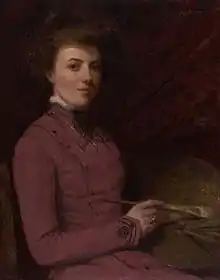 A portrait Helen McNicoll painted by Robert Harris, c 1910 | |
| Born | December 14, 1879 Toronto, Canada |
| Died | June 27, 1915 (aged 35) Swanage, United Kingdom |
| Nationality | Canadian |
| Education | Art Association of Montreal, Slade School of Fine Art |
| Known for | Painting |
| Movement | Impressionism |
| Elected | Royal Canadian Academy of Arts, Royal Society of British Artists |
Biography
Early life
McNicoll was born in Toronto to an affluent family. Her parents were David McNicoll and Emily Pashley who were British immigrants. McNicoll had six siblings—three sisters and three brothers—with letters and sketches proving that the McNicoll family was very close. McNicoll’s parents were members of Montreal’s Anglophone Protestant Elite. Her father David worked in the Railway industry in Scotland and England, allowing Helen to come into close contact with prominent families during the boom of Industrialism. McNicoll, with the financial support of her family through connections with renowned art collectors, would be able to freely paint without worry. McNicoll's first exposure to art presumably came from observing her parents--her father did sketches during his railway travels while her mother painted china and wrote poetry.[2]
Despite the advantages, McNicoll developed severe hearing loss at the age of two due to scarlet fever. McNicoll navigated the social side of the art world through lip reading and assistance from friends and family. In 1899, she participated in activities at the Mackay Institution for Protestant Deaf Mutes; however, she was not listed in official school records and was not listed as deaf in the 1901 census due to misunderstandings of deaf culture in North America at this time. [2]
Education and career
From 1902 to 1904 McNicoll moved to London to study at the Slade School of Fine Art under Philip Wilson Steer; it is also here that McNicoll meets her lifelong partner Dorothea Sharp. Students were encouraged to paint with a naturalistic approach using en plein air. McNicoll then moved to England to study at St. Ives in Cornwall. In 1905, she attended Julius Olsson's School of Landscape and Marine Painting under Algernon Talmage.[3]
McNicoll then began her formal art education at the Art Association of Montreal in 1906,[3] a school with a progressive approach to teaching art by allowing female students to study the nude figure. She began to study under William Brymner, one of the first Canadian artists to study in Paris between 1878 and 1880. As a director of the AAM school, Brymner also encouraged French art trends such as plein air, naturalism, and impressionism in academics. McNicoll was impacted by Brymner as he also encouraged women artists to pursue professional careers. [2]
McNicoll made her debut exhibiting six paintings at annual exhibition at the AAM; she also exhibited with the Royal Canadian Academy of Arts and the Ontario Society of Artists from 1906 to 1914.[4]
McNicoll maintained a studio in London while she traveled around Europe from 1908 up until her death.
World War I
McNicoll and Sharp were working in France when the first World War broke out. McNicoll had written to her father saying that they "would rather be here than anywhere", however due to McNicoll's ties to the Canadian Pacific Railway through her father, she was sent home.[2]
Personal life
While studying at the Slade School, McNicoll met British painter Dorothea Sharp with whom she formed a lifelong bond with, nicknaming each other "Nellie" and "Dolly".[2] The two women traveled together, shared studio spaces, and posed for each other's paintings. In McNicoll's case, having a companion was especially helpful due to obstacles she must have faced due to her hearing loss. McNicoll relied on Sharp's skills in negotiating with models--specifically children, into posing. In The Chintz Sofa by McNicoll, Sharp is depicted in their shared London studio.[2]
Death and legacy
McNicoll died in Swanage, Dorset, at the early age of thirty-six due to complications from diabetes in 1915. An obituary described her as "one of the most profoundly original and technically accomplished of Canadian artists." [5] McNicoll had contributed more than 70 works to exhibitions in both Canada and Britain. Her work would continue to be praised into the 1920s , with the AAM organizing a memorial exhibition of 150 of her paintings celebrating her prolific career. [2] The Art Gallery of Ontario hosted an exhibition of McNicoll's work in 1999.[5]
Style and works
McNicoll was consistently recognized in Canada for her treatment of light and air, bold use of color, and overall "quiet" artworks--possibly influenced by her deafness. Reviewers praised McNicoll's works for their sunny qualities. Subjects of her paintings typically included women, children, and rural landscapes.
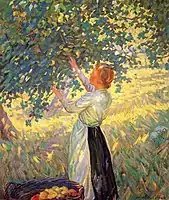 The Apple Gatherer, c. 1911, oil on canvas, 106.8 x 92.2 cm
The Apple Gatherer, c. 1911, oil on canvas, 106.8 x 92.2 cm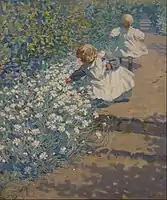 Picking Flowers, c. 1912, oil on canvas, 94 x 78.8 cm
Picking Flowers, c. 1912, oil on canvas, 94 x 78.8 cm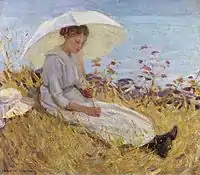 Girl With Parasol, c. 1913, oil on canvas, 40.6 x 45.7 cm
Girl With Parasol, c. 1913, oil on canvas, 40.6 x 45.7 cm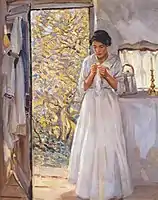 The Open Door, c. 1913, oil on canvas
The Open Door, c. 1913, oil on canvas White Sunshade #2, c. 1912, oil on canvas, 99.5 x 81.9 cm
White Sunshade #2, c. 1912, oil on canvas, 99.5 x 81.9 cm A l'ombre de l'arbre (Circa 1910)
A l'ombre de l'arbre (Circa 1910) Montreal en hiver 1911
Montreal en hiver 1911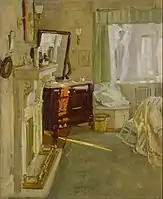 (1905/1915)
(1905/1915)
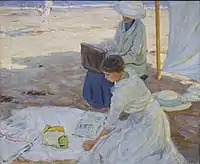 Under the Shadow of the Tent, 1914.
Under the Shadow of the Tent, 1914.
References
- "McNicoll, Helen Galloway". Canadian Women Artists History Initiative. Archived from the original on October 29, 2017. Retrieved October 29, 2017.
- Burton, Samantha (2017). Helen McNicoll: Life & Work. Art Canada Institute. ISBN 978-1-4871-0152-7. Retrieved November 30, 2019.
- Prakash, A.K. (2008). Independent Spirit: Early Canadian Women Artists. Buffalo, New York: Firefly Books. p. 267. ISBN 1554074177.
- Farr, Dorothy; Luckyj, Natalie (1975). From Women's Eyes: Women Painters in Canada. Kingston: Agnes Etherington Art Centre. p. 30.
- "Helen McNicoll: A Canadian Impressionist". Art Gallery of Ontario. Retrieved February 9, 2020.
Further reading
- Natalie Luckyj, Helen McNicoll : a Canadian Impressionist. Toronto : Art Gallery of Ontario, 1999.
- Samantha Burton. Helen McNicoll: Life & Work. Toronto: Art Canada Institute, 2017. ISBN 978-1-4871-0152-7
- A.K. Prakash, Impressionism in Canada: A Journey of Rediscovery. Stuttgart: Arnoldsche Art Publishers, 2015, pp. 491-509. ISBN 978-3-89790-427-9
External links
| Wikimedia Commons has media related to Helen McNicoll. |